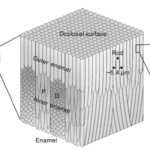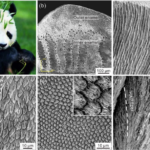Paper, Giant panda’s tooth enamel: Structure, mechanical behavior and toughening mechanisms under indentation
Abstract: The giant panda’s teeth possess remarkable load-bearing capacity and damage resistance for masticating bamboos. In this study, the hierarchical structure and mechanical behavior of the giant panda’s tooth enamel were investigated under indentation. The effects of loading orientation and location on mechanical properties of the enamel were clarified and the evolution of damage in the enamel under increasing load evaluated. The nature of the damage, both at and beneath the indentation surfaces, and the underlying toughening mechanisms were explored. Indentation cracks invariably were seen to propagate along the internal interfaces, specifically the sheaths between enamel rods, and multiple extrinsic toughening mechanisms, e.g., crack deflection/twisting and uncracked-ligament bridging, were active to shield the tips of cracks from the applied stress. The giant panda’s tooth enamel is analogous to human enamel in its mechanical properties, yet it has superior hardness and Young’s modulus but inferior toughness as compared to the bamboo that pandas primarily feed on, highlighting the critical roles of the integration of underlying tissues in the entire tooth and the highly hydrated state of bamboo foods. Our objective is that this study can aid the understanding of the structure-mechanical property relations in the tooth enamel of mammals and further provide some insight on the food habits of the giant pandas.
Learn about our two Decals!
 Click here to find out more about our Fall Bioinspired Design Decal and our Spring Bioinspired Design in Action Decal – ALL MAJORS are welcome.
Click here to find out more about our Fall Bioinspired Design Decal and our Spring Bioinspired Design in Action Decal – ALL MAJORS are welcome.Berkeley BioDesign Community
 Click here to learn about the BioD: Bio-Inspired Design @ Berkeley student organization or here to signup for more info.
Click here to learn about the BioD: Bio-Inspired Design @ Berkeley student organization or here to signup for more info.Search
Student Login





I imagine that the neurological circuits underlying these processes are governed by both 2d spacing maps with their brains as…
to reduce the impact of car accidents, it may be possible to study the force diverting physics of cockroaches to…
you see this type of head-bobbing stability in many avian creatures related to pigeons like chickens. the head ability to…
not like they taught horses how to run! this is an example of convergent evolution where both sea creatures and…
The brain functions in a similar way with neuronal connections. our brains are able to utilize the multiplicity of connections…